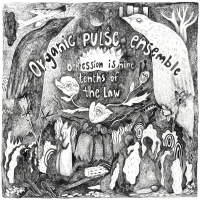Home » Jazz Articles » Genius Guide to Jazz » All About All About Jazz
All About All About Jazz

His first attempt to create an authoritative site is hampered by his medium, the Etch-a-sketch, which suffered from several inherent drawbacks.
Moving ahead to 1957, when Dizzy Gillespie and Charlie Parker conceive of a central clearinghouse for everything jazz-related that anyone could visit at any hour of the day or night. The problem was placing it in a location that was convenient to everyone on the planet. Gillespie favored placing it New York City, arguably the cultural capital of the new world; while Parker wanted to put it in his living room because it seemed like everybody in the damned world was in and out of there while he was trying to watch The Honeymooners.
In 1974, a rather significant event occurred. While working with DARPA to develop a formula for synthetic cool so that American secret agents could score Eastern bloc tail like they did in all those '60s spy movies, Miles Davis stumbled upon a way of getting the primitive computers of the day to communicate with each other over great distances. The plan worked, creating the first network of computers. The interconnecting hardware (tin cans and enormous lengths of waxed string), however, proved cumbersome and unreliable.
Meanwhile, in Philadelphia, a young Michael Ricci (above) began to formulate a way to share his burgeoning love of jazz with the world. His first attempt to create an authoritative site was hampered by his medium, the Etch-a-sketch, which suffered from several inherent drawbacks. First, it was nearly impossible to draw the circular All About Jazz logo (which came to him as though in a dream). Secondly, after it had been passed around a few times, it got fuzzy and hard to read. Third, moving from page to page was labor-intensive and sometimes required hours just to draw a rudimentary HTTP 404-File Not Found message. A subsequent effort using a Lite Brite fared no better.
Initially, young Ricci (no relation to Christina Ricci, because I'm sure if he was he would have hooked me up by now) had wanted to be an inventor. By the age of 11, he had already formulated a working prototype of flubber, but nixed the project for fear Disney would make a horrid movie about it starring Robin Williams as him and Benji as Ted the Wonder Dog. Pretending as though nothing had happened, he took up the trumpet and decided he wanted to be Chet Baker. This didn't pan out, because Chet Baker was still being him and by the time he vacated the post in 1988, Ricci had already graduated from Ohio State and was pursuing a career in cartoons. This was cut short when he lost out for the lead in a new Fox sitcom to a then-unknown Milhouse Van Houten, and the rest is history.
Then, in the early nineties, Ricci discovered the miracle of the Internet. At first just considered a way for teenagers to misspell dirty words to each other in chat rooms, Ricci saw the true potential that laid beyond the garish banner ads and moronic dancing hamsters. After forming his own software company, which was required by law for anyone who owned a computer in the nineties, he set out to combine his lifelong love of jazz with the burgeoning technology now at his fingertips.
In 1995, All About Jazz was born after a few early misfires such as the ill-fated If You Don't Like Jazz Then to Hell With You, and Mike Ricci's Jazz-a-Sketch (which required visitors to shake their monitors in order to move on to the next page). At first just a place for jazz fans to get hip to the latest, it soon blossomed into a breathtaking beauty whose attributes brought grown men to their knees. Or am I still thinking of Christina Ricci?
I shall never tire of that gag.
From the beginning, AAJ was dedicated to the premise that jazz belonged to the people. Not some hothouse diversion for the excessively well-groomed, or an esoteric pastime for people with a liberal arts degree and something to prove, jazz is a living music that is as integral to the American identity as baseball and those movies where the rich boy falls in love with the plucky gal from the wrong side of the tracks and of course his parents disapprove of her but she soon wins their hearts and everyone lives happily ever after except that the sequel tanks at the box office.
So then.
The egalitarian mission of AAJ firmly in place, Ricci began building AAJ into a cornucopia of all possible jazz-related material. To that end, he acquired the rights to virtually every available photograph of a jazz musician stroking their chin thoughtfully and looking into the camera with an expression of stern contemplation. He also purchased virtually everything in Dizzy Gillespie's catalogue (Diz, a tireless crusader for jazz and marketing genius, had compiled a mail-order compendium of jazz-related merchandise. I recently sent away for the beret-shaped salsa bowl, and the deluxe soul patch grooming kit).
Early on, AAJ distinguished itself from its competition by providing a level of jazz coverage heretofore unseen in the electronic media. While other sites were content just to post dry, academic histories and elitist dissertations on the hallowed nature of jazz and how it was too sacred to be entrusted to the heathen masses, AAJ took the reader so deep inside jazz it would take a colonoscopy to find them.
That came out wrong.
As his dream finally began to come to fruition, Ricci began to plan his next move. He could be content with his thriving software business, Screenthemes, and his growing online jazz emporium; or he could set his sights higher, become the next great impresario of the music he loved so much. Like Norman Granz, George Wein and Lt. Gen. Lewis "Chesty" Puller, USMC (Ret.), before him, Ricci saw an unprecedented opportunity to promote the music he loved and gain for himself the sort of rewards that come with serving the higher needs of mankind: obscene amounts of cash and more leg than Sinatra tallied during a long weekend at the Aladdin.
Building AAJ, Ricci was intent that it should always remain about jazz. That may seem obvious, with a name like All About Jazz, but consider how many others had originally began with the same intent and ended up somewhere else entirely. Playboy had once championed jazz as the soundtrack for the modern good life, and now mentions Britney Spears 50-1 more than Miles Davis (I counted. Repeatedly). The letters in Campbell's alphabet soup used to spell out things like "bop" and "john coltrane," but a recent bowl only produced such ambiguous phrases as "go cat" and "i am minus" (it may have been trying to spell "Mingus," but I had already used all the G's to spell "Guggenheim").
Soon, AAJ had grown to include such current staples as CD reviews and, borrowing liberally from the iconic early Playboy, tasteful nudes of jazz musicians (and some disturbing paparazzi photos of King Oliver doing shots of tequila from Bessie Smith's cleavage at Mardi Gras in 1923). Visits to the site increased exponentially, as Web surfers found they could kill two birds with one stone at the emergent hotspot.
As the new millennium dawned, Ricci envisioned an AAJ that not only passively served all conceivable needs of the jazz aficionado, but took an active role in bringing jazz to the people. First, he had to determine who the people were. The "we the people" mentioned in the Constitution were all dead. The motley assortment of chuckleheads on The People's Court didn't deserve anything as wonderful as jazz, and People magazine just seemed to serve as empirical proof that Andy Warhol had overestimated by about 10 minutes.
Finally, Ricci decided that jazz was an American invention, something that only a truly heterogeneous and democratic republic could produce, and thus belonged to all people. Even those who can't seem to figure out what the signal light on their car is for (you know who you are, red Mazda with the vanity plate MCH2KUL) and those who insist on ruining a perfectly good steak by cooking all the taste out of it and then having the nerve to call it well done.
Subsequently.
AAJ began to be a magnet not only for seekers, but for sages as well. All manner of jazz-focused artists began to fill the AAJ servers with their craft (I said craft, not crafts. Don't send us busts of Ken Burns carved out of potatoes. I'm serious). From the uncanny Arcanum of Ken Dryden, who uses his superhuman abilities to discern truths about jazz recordings (he was once able to list the personnel of a set just by smelling the record jacket liner), to the fascinating insights of psychologist Dr. Judith Schlesinger (who maintains that creative personalities are no more prone to mental illness than anyone else, but thinks I'm mad as a hatter), to the surreal and self-referential humor of embryonic steeplejack Jeff Fitzgerald; AAJ has attracted not only the most eclectic and exciting collection of voices currently discussing jazz, but also the tallest (average height 5'9," compared to 5'6" for Jazz Online).
Moreover, AAJ took advantage of the global reach of the Internet to take jazz to every corner of the planet. Or at least, every corner of the earth that had Internet access and wasn't using it solely to collect pictures of cash-strapped coeds in various states of undress. From Australia to Italy to India (changing planes at least twice in Atlanta), AAJ brought jazz to places that had previous considered the pinnacle of American culture to be Roadrunner cartoons (Wile E. Coyote and Acme representing the doomed obsession of the consumer culture, the Roadrunner representing America's love of speed and excess, and the whole intellectual circle-jerk representing a lot of folks with too damned much time on their hands).
With the growth of AAJ as an international phenomenon, Ricci saw the opportunity to build his creation into an engine of economic progress to the betterment of jazz. To that end, he incorporated partnerships with several online retailers to provide almost everything the jazz fan—or even the neophyte—could desire. CD's, posters, t-shirts, books, etc., could all be had from one central location. Ricci created a virtual Wal-Mart of jazz, except without the elderly greeter and no teenagers blasting rap and doing donuts in the parking lot.
As AAJ grew into a multi-headed Hydra, Ricci adjourned himself to his palatial estate in suburban Philadelphia to contemplate not only what his creation had developed into, but what it could yet become. He envisioned AAJ print newspapers in most major cities in the U.S., an online forum for jazz fanatics to exchange thoughts and ideas, a chain of AAJ-themed all-you-can-eat catfish buffets, and an invincible zombie army that would hunt down and eat anyone with a top forty single until jazz is restored to its rightful place in American culture and the mathematical probability of there ever again being another "Who Let the Dogs Out" falls down into the range of statistical anomaly.
His able assistant, Ted the Wonder Dog, at his side, Ricci was able to make the first two goals into realities. With expert help from native Southerners C. Michael Bailey and myself, the catfish buffet is taking shape as we speak (while other jazz sites still try to peddle baked tilapia filets, which is so nineties). And molecular biologist/Managing Editor Nils Jacobson, borrowing heavily from Amway's methods, has almost perfected the formula to raise the dead and turn them into willing slaves. Senior Editor Chris M. Slawecki, heir to the throne of Poland as soon as they find it (the last anyone remembers, the throne was placed in storage after the reign of Stanislas II in 1795 and replaced with a futon because it didn't seem as "la di da"), is currently spearheading AAJ's planned invasion of France, but you aren't supposed to know about that just yet.
AAJ's position as the authoritative place for jazz on the Internet secured in only eight short years, Ricci and crew look forward to the next eight years with relish (it was all that was left in the refrigerator after the weekend). From here, the possibilities are endless. As the world becomes increasingly digital, and the Internet continues the transition from novelty to necessity, AAJ is poised to be the most positive happening in jazz since Alice Blair let John Robert Coltrane round third base with no intention of throwing him out at the plate.
So then.
On behalf of everyone at AAJ, we'd like to thank you for your support and wish you the happiest of holidays. Till next month, exit to your right and enjoy the rest of AAJ.
Continue: More About All About Jazz
Tags
Michael Ricci
Genius Guide to Jazz
Jeff Fitzgerald, Genius
United States
Louis Armstrong
Dizzy Gillespie
Charlie Parker
Miles Davis
Philadelphia
Chet Baker
PREVIOUS / NEXT
Support All About Jazz
 All About Jazz has been a pillar of jazz since 1995, championing it as an art form and, more importantly, supporting the musicians who make it. Our enduring commitment has made "AAJ" one of the most culturally important websites of its kind, read by hundreds of thousands of fans, musicians and industry figures every month.
All About Jazz has been a pillar of jazz since 1995, championing it as an art form and, more importantly, supporting the musicians who make it. Our enduring commitment has made "AAJ" one of the most culturally important websites of its kind, read by hundreds of thousands of fans, musicians and industry figures every month.





















